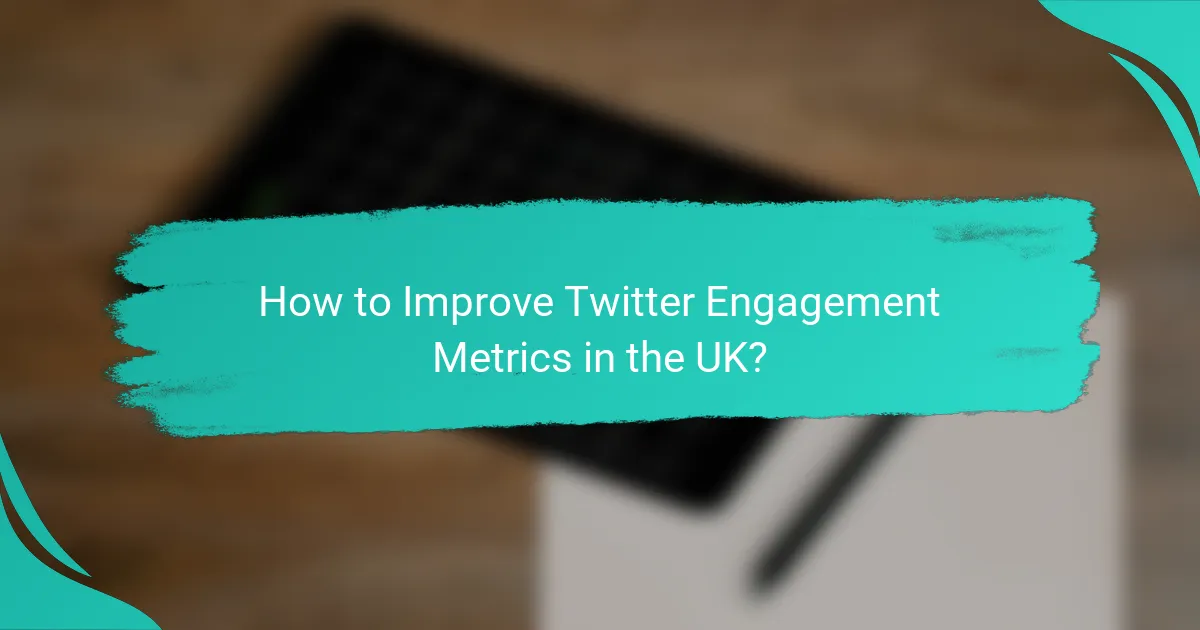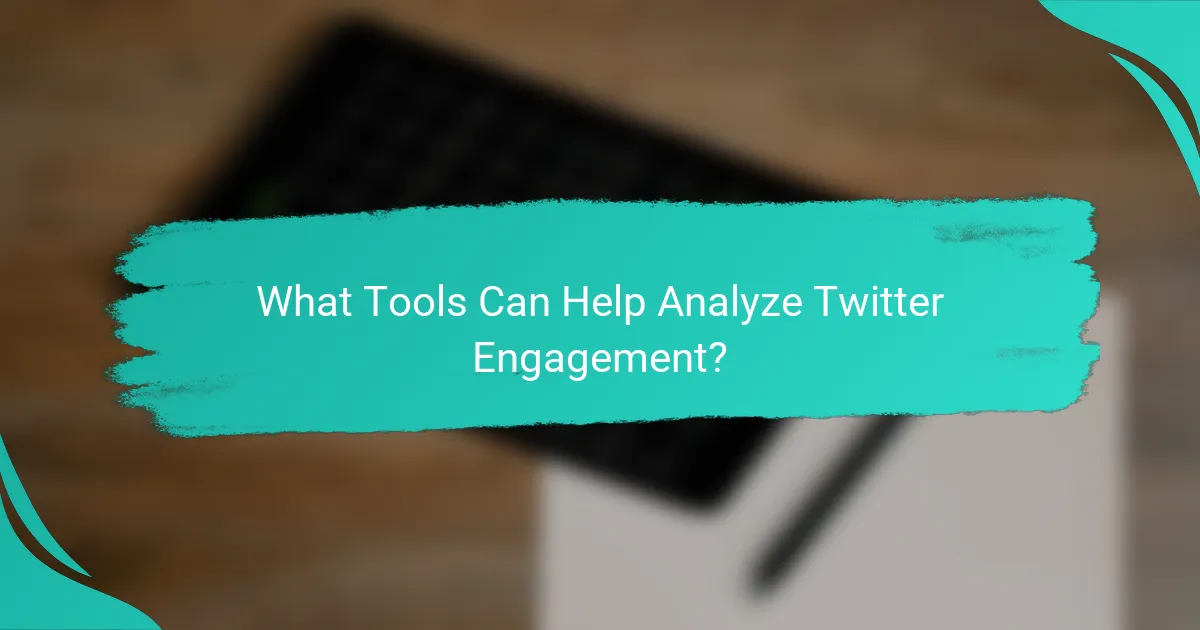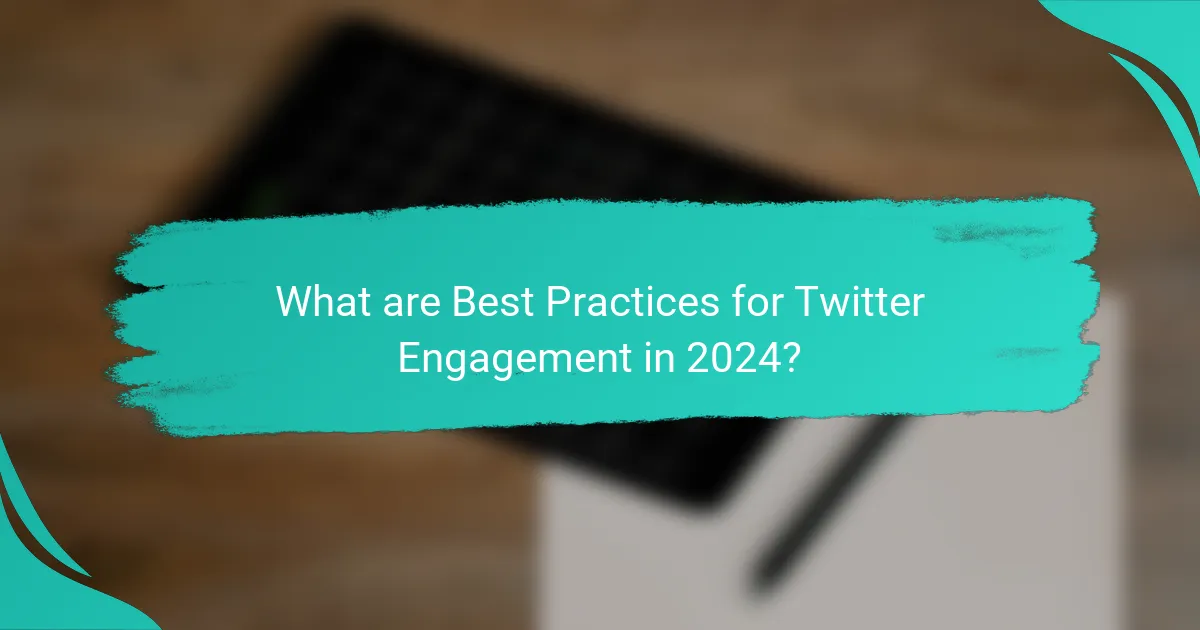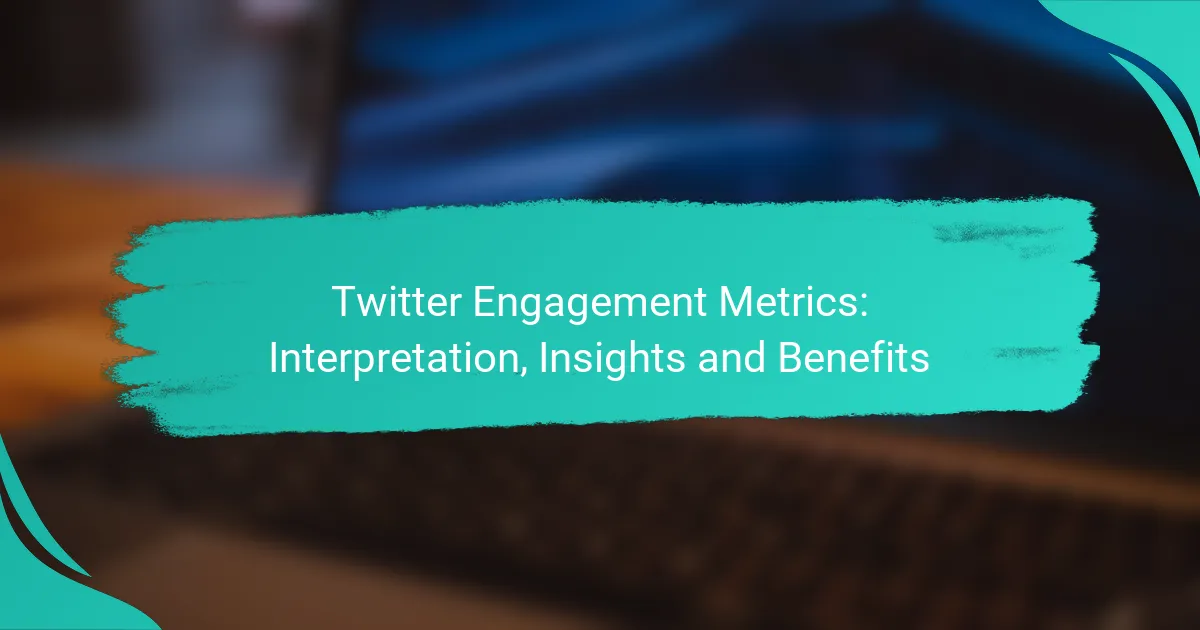Understanding Twitter engagement metrics is essential for maximizing your presence on the platform. By analyzing key indicators such as retweets, likes, and replies, you can gain valuable insights into audience preferences and refine your content strategy. Consistent interaction and data-driven approaches can significantly enhance engagement rates, leading to a more impactful Twitter experience.

How to Improve Twitter Engagement Metrics in the UK?
To enhance Twitter engagement metrics in the UK, focus on understanding your audience and consistently interacting with them. Implementing data-driven strategies and optimizing content can lead to significant improvements in engagement rates.
Utilize Twitter Analytics for Insights
Twitter Analytics provides valuable insights into your account’s performance, including engagement rates, impressions, and follower demographics. Regularly reviewing these metrics helps identify what content resonates with your audience and what doesn’t.
Pay attention to trends over time, such as which tweets generate the most engagement. Use this data to refine your content strategy and focus on topics that spark interest among your followers.
Engage with Followers Consistently
Consistent engagement with your followers is crucial for building a loyal community. Respond to comments, retweet relevant content, and participate in conversations to foster a sense of connection.
Consider setting aside time each day to interact with your audience. This could involve replying to mentions or direct messages, which can significantly enhance your engagement metrics.
Leverage Hashtags Effectively
Using relevant hashtags can increase the visibility of your tweets and attract a wider audience. Research popular hashtags within your niche and incorporate them strategically in your posts.
Avoid overloading your tweets with hashtags; one to three well-chosen tags are often sufficient. This approach helps maintain clarity while expanding your reach.
Post at Optimal Times
Timing plays a vital role in Twitter engagement. Posting when your audience is most active can lead to higher interaction rates. Generally, weekdays during lunchtime and early evenings are effective times to tweet.
Experiment with different posting times and analyze the engagement data to find the optimal schedule for your specific audience in the UK.
Use Visual Content to Boost Engagement
Incorporating visual content, such as images, videos, and GIFs, can significantly enhance engagement on Twitter. Tweets with visuals tend to receive more retweets and likes compared to text-only posts.
Ensure that your visuals are relevant and high-quality. A well-designed image or an engaging video can capture attention and encourage followers to interact with your content.

What are Key Twitter Engagement Metrics?
Key Twitter engagement metrics include retweets, likes, and replies, which help assess how well content resonates with the audience. Understanding these metrics enables users to refine their strategies for better interaction and reach on the platform.
Retweets as a Measure of Reach
Retweets indicate how many times users have shared your tweet with their followers, serving as a direct measure of content reach. A higher number of retweets suggests that your message is being amplified across the platform, potentially reaching a wider audience.
To maximize retweets, focus on creating shareable content, such as insightful commentary, humor, or visually appealing media. Aim for a retweet rate of around 1-3% of your followers as a benchmark for effective engagement.
Likes Indicating Content Resonance
Likes reflect how well your content resonates with your audience, serving as a quick indicator of approval. A tweet with a high number of likes typically signifies that the content is engaging or relatable to your followers.
To increase likes, ensure your tweets are relevant and timely, and consider using popular hashtags. Aiming for a like rate of 2-5% of your followers can be a good target for measuring content effectiveness.
Replies Reflecting Audience Interaction
Replies show direct interaction from your audience, indicating that your content has sparked conversation or prompted questions. A higher number of replies suggests that your audience is engaged and interested in discussing the topic further.
Encourage replies by asking open-ended questions or prompting discussions in your tweets. Monitoring the reply rate can provide insights into audience sentiment and areas for improvement, with a target of around 0.5-1% of your followers engaging in conversation being a reasonable goal.

How to Interpret Twitter Engagement Metrics?
Interpreting Twitter engagement metrics involves analyzing how users interact with your content, including likes, retweets, replies, and clicks. These metrics provide insights into audience preferences and the effectiveness of your messaging strategy.
Understanding Engagement Rate Calculation
The engagement rate is calculated by dividing the total engagements (likes, retweets, replies) by the total impressions or reach, then multiplying by 100 to get a percentage. For example, if a tweet receives 100 engagements and has 1,000 impressions, the engagement rate would be 10%.
It’s essential to consider that engagement rates can vary significantly across different industries and types of content. A higher engagement rate typically indicates that your audience finds your content relevant and compelling.
Contextualizing Metrics with Industry Benchmarks
To effectively interpret your engagement metrics, compare them against industry benchmarks. For instance, engagement rates for brands in the technology sector might average around 1-3%, while those in the entertainment industry could see rates of 3-5% or higher.
Utilizing these benchmarks helps you assess whether your engagement is on par with competitors or if adjustments are needed. Regularly reviewing these metrics can guide your content strategy and improve overall performance on the platform.

What Benefits Do Twitter Engagement Metrics Provide?
Twitter engagement metrics offer valuable insights into how users interact with your content, helping to refine strategies and improve overall performance. By analyzing these metrics, brands can enhance visibility, foster relationships, and drive traffic effectively.
Enhancing Brand Awareness
Engagement metrics such as retweets, likes, and replies indicate how well your content resonates with your audience. High engagement rates can lead to increased visibility, as Twitter’s algorithm often promotes popular tweets to a broader audience. Brands can use this data to identify which types of content generate the most interest and tailor their messaging accordingly.
For example, if a specific tweet format or topic consistently garners high engagement, consider producing more content in that style. This approach not only boosts brand awareness but also reinforces your brand identity in the minds of users.
Improving Customer Relationships
Monitoring engagement metrics allows brands to understand customer preferences and sentiments. By responding to comments and engaging with users who interact with your posts, you can build stronger relationships and foster loyalty. This two-way communication can lead to valuable feedback and insights into customer needs.
To enhance customer relationships, consider setting up alerts for mentions and direct messages. This proactive approach ensures timely responses and demonstrates that you value customer input, which can significantly improve brand perception.
Driving Website Traffic
Engagement metrics can directly influence the amount of traffic directed to your website. Tweets that receive high engagement often lead to increased clicks on links shared within the posts. By analyzing which tweets drive the most traffic, brands can refine their content strategy to focus on high-performing topics.
To maximize website traffic, include clear calls-to-action in your tweets, encouraging users to visit your site for more information. Additionally, consider using URL shorteners to track click-through rates and assess the effectiveness of different campaigns.

What Tools Can Help Analyze Twitter Engagement?
Several tools can effectively analyze Twitter engagement, providing insights into audience interactions and content performance. These tools help track metrics such as likes, retweets, replies, and overall reach, enabling users to refine their social media strategies.
Hootsuite for Comprehensive Analytics
Hootsuite offers a robust analytics dashboard that aggregates data from various social media platforms, including Twitter. Users can monitor engagement metrics like follower growth, post performance, and audience demographics, allowing for a holistic view of social media impact.
One key feature is the ability to generate customized reports, which can be scheduled for regular delivery. This helps teams stay informed about their Twitter engagement trends without manual tracking.
Sprout Social for Engagement Tracking
Sprout Social specializes in engagement tracking, providing detailed insights into how audiences interact with tweets. Its Smart Inbox consolidates all messages, mentions, and comments, making it easier to respond promptly and effectively.
The platform also offers engagement metrics that highlight the best-performing content and times for posting. This information can guide users in optimizing their Twitter strategy to enhance audience interaction.
Buffer for Scheduling and Insights
Buffer is known for its scheduling capabilities but also provides valuable insights into Twitter engagement. Users can plan their posts ahead of time while analyzing how different types of content perform over time.
Buffer’s analytics feature allows users to track key metrics such as click-through rates and engagement ratios. This data can inform future content decisions, ensuring that tweets resonate with the target audience.

What are Best Practices for Twitter Engagement in 2024?
To maximize Twitter engagement in 2024, focus on creating authentic content, interacting with your audience, and staying updated on platform changes. Consistency and understanding your audience’s preferences are key to fostering meaningful connections.
Adapting to Algorithm Changes
Twitter’s algorithm frequently evolves, impacting how content is displayed to users. Staying informed about these changes allows you to adjust your strategies effectively, ensuring your tweets reach a wider audience.
Key considerations include posting times, content types, and engagement tactics. For instance, tweets with images or videos often receive higher engagement, so incorporate multimedia elements into your posts.
Regularly review your analytics to identify which types of content perform best. This data can guide your future posts and help you adapt to algorithm shifts, enhancing your overall engagement strategy.
